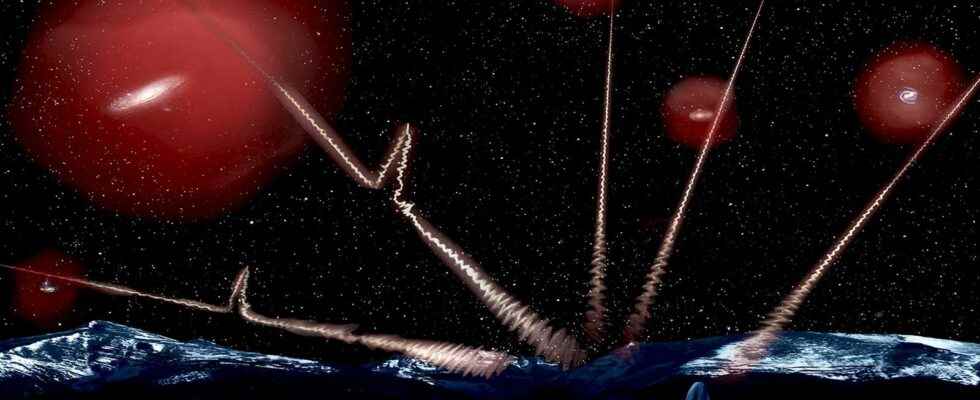We still do not know their origin, but they could well prove useful. In a study published in the journal Nature Astronomyresearchers were able to calculate the mass halos diffuse which surround galaxies standing in the way between a fast radio burst and us. First discovered in 2007, fast radio bursts, often shortened to FRB to Fast radio bursts are very fast signals, of a duration average of a few milliseconds, taking place in the radio wave range. Very energetic, in these few thousandths of a second they release as manyenergy than the Sun in a day! First attributed to instrumental biases or extraterrestrial civilizations, they could come from many energetic astronomical objects: supernovaof the pulsarof the black holesand even magnetars !
The halos that surround galaxies are hard to scrutinize
What is certain is that we receive them from everywhere, and a lot, up to 10,000 a day! Some also have a periodicity, or repeat themselves indefinitely, such as FRB 20190520B, a rapid burst that is repeated over and over again, without researchers being able to define a cycle! But if, failing to understand them perfectly, we used them to explore other stars well known ? It is the idea of the researchers of the California Institute of Technologywho decided to probe the halos of gas diffuse that surround the galaxies.
Indeed, these consist of much more than just their matter seen by our telescopes. Beyond the stellar halo lies the galactic corona: it consists of hot gas that fuels star creation while collecting debris left behind by violent star explosions, supernovas. But cloud of matter is difficult to observe, because of its low density, less than one particle per cubic centimeter. “These gas reservoirs are huge. If theeye human could see the spherical halo that surrounds the nearby Andromeda galaxy, the halo would appear a thousand times larger than the moon », explains Liam Connor, first author of the study and postdoctoral fellow in astronomy at Caltech. But what surrounds this immense halo is not: still beyond the galactic crown is a halo of black matter. Present in all galaxies, it surrounds them well beyond their visible envelope, and contributes most of their mass.
Fast radio bursts, “skewers” of matter between our telescopes and their source
Today, researchers are proposing an innovative solution for exploring galactic halos: observing the dispersion of fast radio bursts, and deducing the gaseous mass they have passed through. Indeed, the latter correspond to pulses emitted in a range of frequencies, and can therefore split into several single frequency signals. As they make their way to us, they encounter electrons which accompany the surrounding material, in particular that of galactic halos. However, each time an electron meets, these signals are slowed down: in general, the longer the wavelength (therefore the lower the frequency), the stronger the slowing down. Dispersion measurements consist in studying the lengthening of a signal by measuring the accumulated delay, and in deducing the quantity of electrons, and therefore of matter, that it has encountered. “We used fast radio bursts to shine a light through the halos of galaxies near the Milky Way and measure their hidden matter”explains Liam Connor.
To test their method, the researchers used a sample of 474 fast radio bursts recorded by the Canadian Earth Mapping Experiment.hydrogen (CHIME), a radio telescope located in British Columbia. They then compared the dispersion measurements for each burst, and combined this data with the presence or absence of galaxies in their path. And they concluded that indeed, the intersecting bursts of galaxies were much slower than the others. “Our study shows that FRBs can act as skewers of all matter between our radio telescopes and the source of the radio waves”, enthuses Liam Connor. They also calculated the mass encountered by these fast radio bursts corresponding to the galactic halo encountered, and measured a quantity of matter twice as high as the theoretical quantity! ” This is just the beginning “says Vikram Ravi, co-author of the study and professor of astronomy at Caltech. “As we discover more FRBs, our techniques can be applied to study individual halos of different sizes and in different environments, addressing the unsolved problem of matter distribution in theuniverse. »
Reading ideas for the summer with Futura?
To celebrate the start of the holidays, we offer you the Mag Futura at the preferential price of 15 € instead of 19 €, i.e. a reduction of 20% !
What is Mag Futura?
- Our first paper journal of more than 200 pages to make science accessible to as many people as possible
- 4 major scientific questions for 2022, from the Earth to the Moon
- Home delivery*
*Special offer valid until July 19. Delivery is made in France (excluding metropolitan France), Switzerland, Belgium.
Interested in what you just read?
